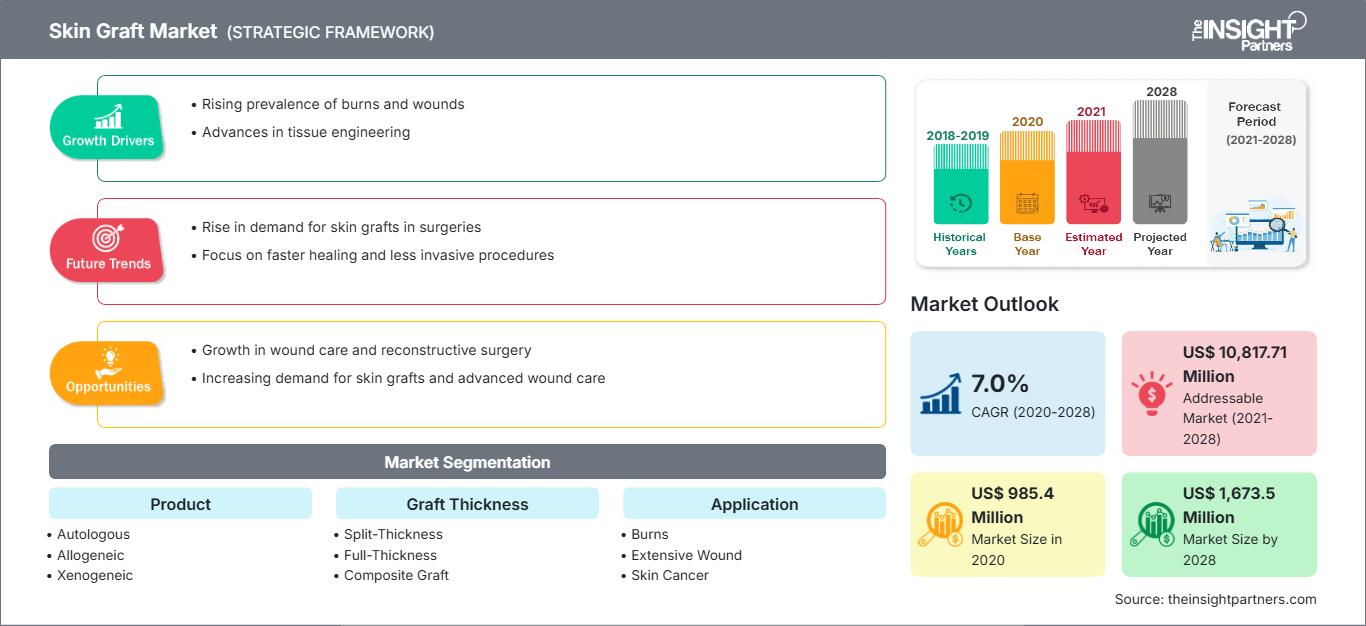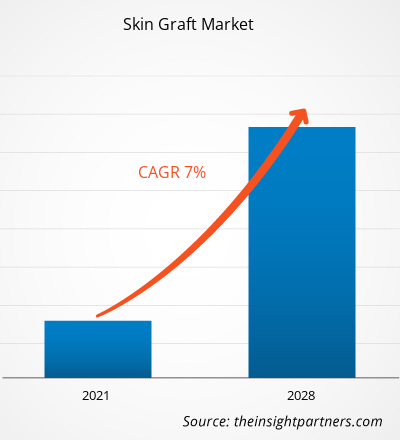Der Markt für Hauttransplantationen hatte im Jahr 2020 einen Wert von 985,4 Millionen US-Dollar und soll bis 2028 1.673,5 Millionen US-Dollar erreichen; von 2021 bis 2028 wird ein CAGR-Wachstum von 7,0 % erwartet.
Eine Hauttransplantation ist ein chirurgischer Eingriff, bei dem Haut mithilfe verschiedener Arten von Hauttransplantaten transplantiert wird. Hauttransplantate werden auch zur Behandlung von großflächigen Verletzungen, Traumata und Verbrennungen eingesetzt. Bei einer Hauttransplantation wird ein kleines Stück Haut von einem Körperteil des Patienten entnommen und an der betroffenen Körperstelle befestigt oder transplantiert. Das Stück Haut wird an die verletzte oder verbrannte Stelle transplantiert oder dort befestigt. Der Markt für Hauttransplantationen ist nach Produkt, Transplantatdicke, Anwendung, Ausrüstung, Endverbrauchern und Region segmentiert. Der Markt ist regional in Nordamerika, Europa, Asien-Pazifik, Naher Osten und Afrika sowie Süd- und Mittelamerika unterteilt. Der Bericht bietet Einblicke und eine eingehende Analyse des Hauttransplantationsmarktes und legt dabei den Schwerpunkt auf verschiedene Parameter wie Markttrends, technologische Fortschritte, Marktdynamik und eine Analyse der Wettbewerbslandschaft führender Marktteilnehmer weltweit. Er berücksichtigt auch die Auswirkungen der COVID-19-Pandemie auf den Markt in allen Regionen. Aufgrund des Ausbruchs von COVID-19 waren verschiedene Krankenhäuser mit der Behandlung der betroffenen Infizierten beschäftigt. Da außerdem verschiedene Wundversorgungszentren in den Krankenhäusern betrieben werden, kann die Mehrheit der Patienten keine Wundbehandlung erhalten. ~ Ungefähr jeder vierte Patient kann eine Wundbehandlung erhalten und es wird geschätzt, dass in den USA fast 6,7 Millionen Menschen auf eine Wundbehandlung warten. Forscher untersuchten die Stabilität von SARS-CoV-2 und Influenza-A-Viren (IAV), gemischt mit Kulturmedium oder Schleim der oberen Atemwege, auf menschlicher Haut sowie die dermale Desinfektionswirkung von 80-prozentigem Ethanol (w/w) gegen SARS-CoV-2 und IAV. Um eine Infektion gesunder Freiwilliger zu vermeiden, führten die Forscher Laborexperimente mit Leichenhaut durch, die sonst für Hauttransplantationen verwendet worden wäre. Der Ausbruch von COVID-19 hat den Markt für Hauttransplantationen stark beeinträchtigt, da die Qualität der Versorgung beeinträchtigt wurde.
Passen Sie diesen Bericht Ihren Anforderungen an
Sie erhalten kostenlos Anpassungen an jedem Bericht, einschließlich Teilen dieses Berichts oder einer Analyse auf Länderebene, eines Excel-Datenpakets sowie tolle Angebote und Rabatte für Start-ups und Universitäten.
Markt für Hauttransplantationen: Strategische Einblicke

-
Holen Sie sich die wichtigsten Markttrends aus diesem Bericht.Dieses KOSTENLOSE Beispiel umfasst Datenanalysen, die von Markttrends bis hin zu Schätzungen und Prognosen reichen.
Markteinblicke
Steigende Prävalenz von Hautkrebs und Diabetes
Hauttransplantationen werden nach Operationen bei Hautkrebs bevorzugt. Hauttransplantationen werden im Allgemeinen für eine lokale postoperative Strahlentherapie (PORT) überwiesen, um den Verschluss des während der Strahlentherapie entstandenen Operationsbetts sicherzustellen. Laut Cancer Research UK werden in Großbritannien jedes Jahr etwa 15.400 neue Fälle von schwarzem Hautkrebs registriert, das sind 42 Neuerkrankungen pro Tag. Die Inzidenzrate von schwarzem Hautkrebs wird in Großbritannien zwischen 2014 und 2035 voraussichtlich um 7 % auf 32 Fälle pro 100.000 Menschen bis 2035 steigen. Ebenso wurden laut der jüngsten Statistik der Internationalen Agentur für Krebsforschung im Jahr 2020 19,3 Millionen neue Krebsfälle registriert, davon nicht 18,1 Millionen für nicht-melanozytären Hautkrebs. Daher wird die zunehmende Verbreitung von Hautkrebs in Zukunft wahrscheinlich zu Hauttransplantationen beitragen. Diabetes gehört zu den weltweit am weitesten verbreiteten Gesundheitszuständen. Laut der 9. Ausgabe des IDF Diabetes Atlas 2019 der International Diabetes Federation (IDF) lebten weltweit etwa 463 Millionen Erwachsene mit Diabetes. Bis 2045 wird die Prävalenz auf 700 Millionen geschätzt – das sind fast 79 % aller Erwachsenen mit Diabetes in Ländern mit niedrigem und mittlerem Einkommen weltweit. Unter den Diabetes-Prävalenzen steigt der Anteil der Fälle von Typ-2-Diabetes viel schneller an. Laut IDF besteht für 374 Millionen Menschen das Risiko, in naher Zukunft an Typ-2-Diabetes zu erkranken. Bei Diabetikern dauert die Wundheilung lange, was das Risiko von Hautinfektionen erhöht, wenn die Wunde nicht innerhalb einer bestimmten Zeit verheilt. Etwa 25 % aller Diabetiker entwickeln einmal in ihrem Leben Fußgeschwüre, die oft eine erweiterte diabetische Wundversorgung erfordern. Daher steigt die Nachfrage nach Hauttransplantaten zur Behandlung oder Abdeckung diabetischer Fußgeschwüre, da sie das Risiko von Hautinfektionen eliminieren. Die hohe Prävalenz von Hautkrebs und Diabetes dürfte den Markt für Hauttransplantate in naher Zukunft ankurbeln.
Produktbasierte Erkenntnisse
Der Markt für Hauttransplantate ist nach Typ in autologe, allogene, xenogene, prothetische und isogene Transplantate unterteilt. Das autologe Segment hatte 2020 den größten Marktanteil auf dem globalen Markt für pharmazeutische Zwischenprodukte, und es wird erwartet, dass der Markt für dasselbe Segment zwischen 2021 und 2028 am schnellsten wachsen wird. Das Marktwachstum im autologen Segment ist auf die breite Verwendung autologer Transplantate zur Behandlung offener Verbrennungen und Wunden zurückzuführen.Anwendungsbasierte Erkenntnisse
Basierend auf der Anwendung ist der Markt für Hauttransplantationen in Verbrennungen, großflächige Wunden, Hautkrebs und andere Anwendungen unterteilt. Das Segment Verbrennungen hatte 2020 den größten Marktanteil. Es wird geschätzt, dass dasselbe Segment im Prognosezeitraum die höchste durchschnittliche jährliche Wachstumsrate (CAGR) verzeichnet. Unternehmen setzen häufig auf anorganische Strategien wie Partnerschaften sowie Fusionen und Übernahmen, um der sich ändernden Kundennachfrage gerecht zu werden und ihren Markennamen weltweit zu behaupten. Marktteilnehmer im Hauttransplantationsmarkt verfolgen auch organische Strategien wie Produkteinführungen und -erweiterungen, um ihre Präsenz und ihr Produktportfolio weltweit zu erweitern und die wachsende Nachfrage zu decken.Hauttransplantation
Regionale Einblicke in den HauttransplantationsmarktDie Analysten von The Insight Partners haben die regionalen Trends und Faktoren, die den Markt für Hauttransplantationen im Prognosezeitraum beeinflussen, ausführlich erläutert. In diesem Abschnitt werden auch die Marktsegmente und die geografische Lage in Nordamerika, Europa, dem asiatisch-pazifischen Raum, dem Nahen Osten und Afrika sowie Süd- und Mittelamerika erörtert.
Umfang des Marktberichts über Hauttransplantationen
| Berichtsattribut | Einzelheiten |
|---|---|
| Marktgröße in 2020 | US$ 985.4 Million |
| Marktgröße nach 2028 | US$ 1,673.5 Million |
| Globale CAGR (2020 - 2028) | 7.0% |
| Historische Daten | 2018-2019 |
| Prognosezeitraum | 2021-2028 |
| Abgedeckte Segmente |
By Produkt
|
| Abgedeckte Regionen und Länder |
Nordamerika
|
| Marktführer und wichtige Unternehmensprofile |
|
Dichte der Marktteilnehmer für Hauttransplantationen: Verständnis ihrer Auswirkungen auf die Geschäftsdynamik
Der Markt für Hauttransplantationen wächst rasant. Die steigende Nachfrage der Endverbraucher ist auf Faktoren wie veränderte Verbraucherpräferenzen, technologische Fortschritte und ein stärkeres Bewusstsein für die Produktvorteile zurückzuführen. Mit der steigenden Nachfrage erweitern Unternehmen ihr Angebot, entwickeln Innovationen, um den Bedürfnissen der Verbraucher gerecht zu werden, und nutzen neue Trends, was das Marktwachstum weiter ankurbelt.

- Holen Sie sich die Markt für Hauttransplantationen Übersicht der wichtigsten Akteure
- Autolog
- Allogen
- Xenogen
- Prothetisch
- Isogen
Nach Transplantatdicke
- Spaltdicke
- Volldicke
- Verbundtransplantat
Nach Anwendung
- Verbrennungen
- Ausgedehnte Wunden
- Hautkrebs
- Andere Anwendungen
Nach Ausrüstung
- Dermatom
- Allgemeine chirurgische Instrumente
- Verbrauchsmaterialien
- Andere Märkte
Nach Endverbrauchern
- Krankenhäuser
- Ambulante chirurgische Zentren
- Dermatologie Kliniken
Nach Geografie
-
Nordamerika
- USA
- Kanada
- Mexiko
-
Europa
- Frankreich
- Deutschland
- Italien
- Großbritannien
- Spanien
- Restliches Europa
-
Asien-Pazifik (APAC)
- China
- Indien
- Südkorea
- Japan
- Australien
- Restliches APAC
-
Naher Osten und Afrika (MEA)
- Südafrika
- Saudi-Arabien
- VAE
- Rest von MEA
-
Süd- und Mittelamerika (SCAM)
- Brasilien
- Argentinien
- Rest von SCAM
Firmenprofile
- B. Braun Melsungen AG
- Integra Life Sciences Corporation
- Smith & Nephew
- AVITA Medical
- MiMedx
- Organogenesis Inc
- Tissue Regenix Group
- Zimmer Biomet
- De Soutter Medical
- Nouvag AG
- Historische Analyse (2 Jahre), Basisjahr, Prognose (7 Jahre) mit CAGR
- PEST- und SWOT-Analyse
- Marktgröße Wert/Volumen – Global, Regional, Land
- Branchen- und Wettbewerbslandschaft
- Excel-Datensatz
Aktuelle Berichte
Erfahrungsberichte
Grund zum Kauf
- Fundierte Entscheidungsfindung
- Marktdynamik verstehen
- Wettbewerbsanalyse
- Kundeneinblicke
- Marktprognosen
- Risikominimierung
- Strategische Planung
- Investitionsbegründung
- Identifizierung neuer Märkte
- Verbesserung von Marketingstrategien
- Steigerung der Betriebseffizienz
- Anpassung an regulatorische Trends






















 Kostenlose Probe anfordern für - Markt für Hauttransplantationen
Kostenlose Probe anfordern für - Markt für Hauttransplantationen